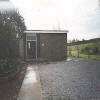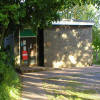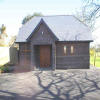|
A Brief History of St. Brides Major |
Return to main
History page
Other History pages: St.
Brides Major | Southerndown |
Ogmore-by-Sea |
Marine | School
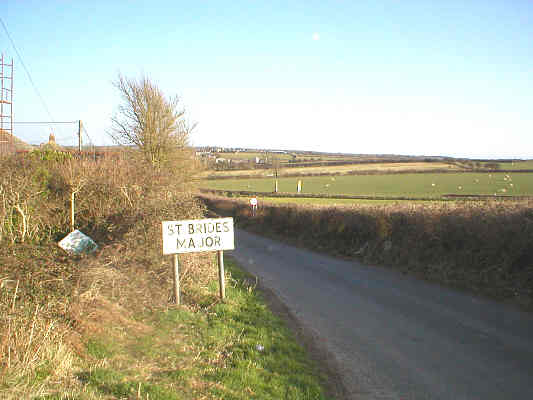
St Brides Major sign (from Heol y Mynydd)
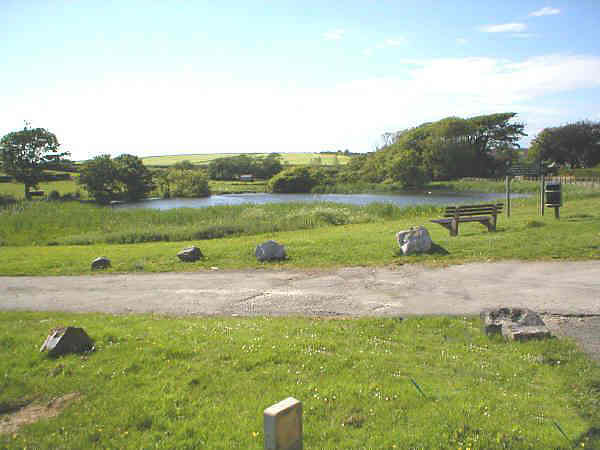
Pitcot Pool
Opposite the Farmers Arms, on Pitcot Green, there were two semi-detached cottages. It was in one of these that the Baptist Faith was founded in the Parish, by Peggy Saunders. Horeb Chapel, located near the centre of the village on Ewenny Road was built in 1863 on a site given by Mr. Evan Smith of Great House, Southerndown. Originally copyhold, it later became freehold. Services were held until 14th December, 2003 when, owing to a fall in membership and congregation numbers, Horeb closed. The final service was conducted by Father Michael Komor, Vicar of Ewenny with St. Brides Major. The pulpit chair as well as a chair given in memory of Mr. Desmond Lintern were placed in All Saints Church, Southerndown, and the Bible given to St. Brides Major School.
Left photo: Horeb Chapel, St. Brides
Major, in 2002.
Right photo: Interior of Horeb Chapel (date unknown)
Originally, the village Post Office was housed in a thatched dwelling at the lower end of St. Brides Major called Pant Cottage. In the early 1900s it moved to Bull Hill Cottage (near the junction of Southerndown Road) and then to the centre* of the village opposite the footpath to the current school, where it was based for many years. Here, Mr. David Evans and his wife Margaret also kept the only shop (until a second was built in the 1970s, originally a VG mini supermarket). Mr. Evans was a President of the South Wales and Monmouthshire Grocers' Federation and a member of the Bridgend and District Rotary Club. The shop was refurbished with major alterations in the 1990s then on its closure the Post Office was transferred to its present location in the Spar and some time later the premises were split back into two units, one selling exclusive ladieswear and one jewellery, until 2009 since when there have been several businesses here including one for model railway components.
* Next to these premises is a ground floor building constructed of stone which used to be a blacksmith's shop. Originally it had a pitched roof which was subsequently reinforced and used as an air-raid shelter during the Second World War. It has also served as a garage and stores. Lorenzo Bevan was the blacksmith and his wife ran the Post Office in Bull Hill Cottage.
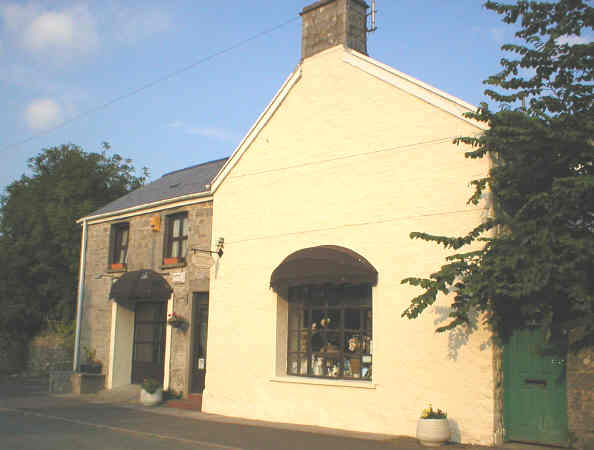
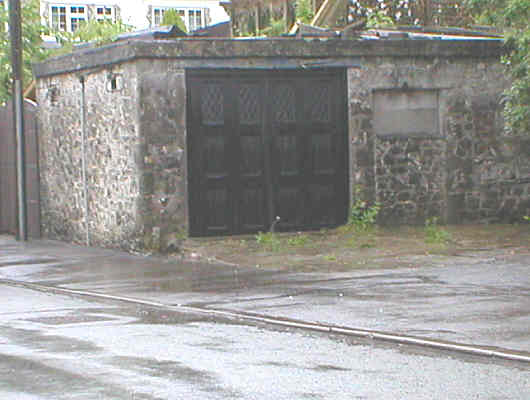
Left photo: Originally a blacksmiths, this
building was an air raid shelter during the World War II then a stores for the
village shop next door
Right photo: The Old Post Office, St. Brides Major, in 2005. This was also the
site of the first village shop
The long high-roofed building opposite the Mace Village shop on Ewenny Road, now private residences, was once the Greyhound Inn. Carriages and horses could be stabled here while the owners were attending St. Bridget's Church. The Fox and Hounds Inn used to brew its own ale and hop vines could still be seen in the 1980s on a high wall bank behind the premises. The lane behind (Heol Fach) is known locally as Fox Lane and is suitable only for small vehicles or on foot.
There was once a shoemaker's shop in The Pant and a baker's on Fox Lane with a communal bake-house that local people could use on Fridays. This has now been converted into a dwelling.
On Penylan Road is the building which was Bryn Sion Calvinistic Methodist Chapel, built in 1859. In the early 1900s, Mr. Thomas Howe, who was a Deacon of the Chapel and conductor of the Choir, also kept the village shop. Mr. Thomas Morgan of Penuchadre Farm played the organ. Margaret Howells (nee Morgan in the 1920s) of Sealands Farm and Penwchadre Farm was also an organist The Chapel closed in October, 1987 and after many years of neglect, the building was sold and refurbished to become residential. Two wall plaques from the Chapel were placed in the Vestry of St. Bridget's Church.
Archived documentation at the National
Library of Wales shows:
Form certifying Bryn Sion Chapel as a place of meeting for religious worship
dated 13 January 1905;
Superintendent Registrar's certificate of the registry of Bryn Sion Chapel for
the solemnisation of marriages dated 30 January 1905;
Letter from the Registrar General informing the Rev. T. Watkins that he may act
as Responsible Authorised Person for Bryn Sion Chapel dated 4 November 1912;
Printed minutes of a meeting of the Glamorgan Presbytery West dated 13 March
1952, with an agenda for the meeting to be held on 7 May 1952;
Certificate of trustees authorising William James Price to be present to
register marriages in Bryn Sion Chapel dated 23 April 1956.
Register containing details of marriages performed in Bryn Sion Chapel,
1912-1969;
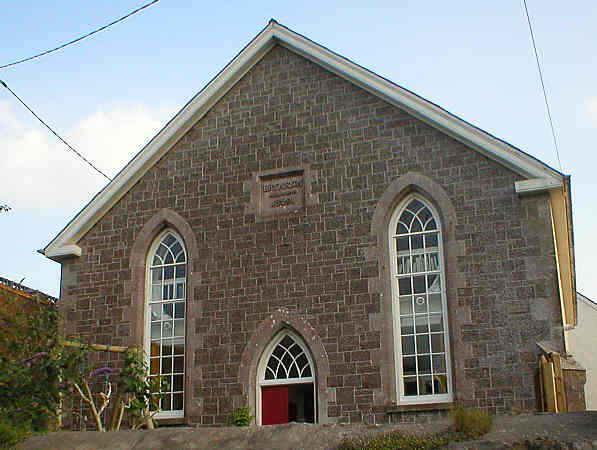
Bryn Sion Calvinistic Methodist Chapel in 2005
Also on Penylan Road is a double-fronted house called Crofta, which was once a police station and a blacksmith's shop. It was in the large croft attached to the house that people in the district gathered for the last time before emigrating to Salt Lake City to join Brigham Young in the Mormon faith. It has been said the work of the missionaries was so successful that the population of St. Brides Major was depleted. Descendants of those people still visit the district and keep contact with villagers.
Population of St. Brides Major
| Year |
Population |
|
| Male | Female | |
| 1841 | 437 | 477 |
| 1851 | 393 | 414 |
| 1861 | 402 | 424 |
| 1871 | 376 | 390 |
| 1881 | 330 | 344 |
| 1891 | 304 | 317 |
In 1919 the Rev. Frank Picton Warlow formed a committee which raised funds from all denominations of the Parish in order to purchase a sectional building to be used as a village hall. The intention was for young people of the Parish returning to civilian life from the services to have somewhere to go to enjoy themselves in the evenings. It was non-political and non-sectarian. Subscriptions were received from all denominations in the parish and various functions were held in the village school to augment the fund. Eventually, a sectional building was purchased and erected near the junction of Southerndown Road in the centre of the village. Known as the Village Institute, it was a huge success and an ante-room and canteen were soon added. A full-sized billiards table was purchased from Dunraven Castle by Mr. R. M. Dillwyn of Castle-upon-Alun and presented to the committee enabling tournaments to be held. Many events were held including dances, whist-drives, concerts and public meetings. No land had been purchased as it was erected on "Glebe" land which resulted in the building eventually being run as a Church Hall. Some time later, further fund-raising enabled a more modern building to be erected on the site. Replacement gates were donated in 1998 by Southerndown WI to mark their 50th anniversary. In 2005 an extension was built and the first phase of refurbishment undertaken to create a new room, accessible toilet facilities and storage area downstairs and a meeting room upstairs. The building is still in constant use by all sections of the community. Mr Gardener's picture of the bottom of the village which used to be in the Fox & Hounds is now hanging in the Church Hall.
....and don't forget to see the St. Brides Major picture gallery!!
Other History pages: St.
Brides Major | Southerndown |
Ogmore-by-Sea |
Marine | School
Return to main History page
